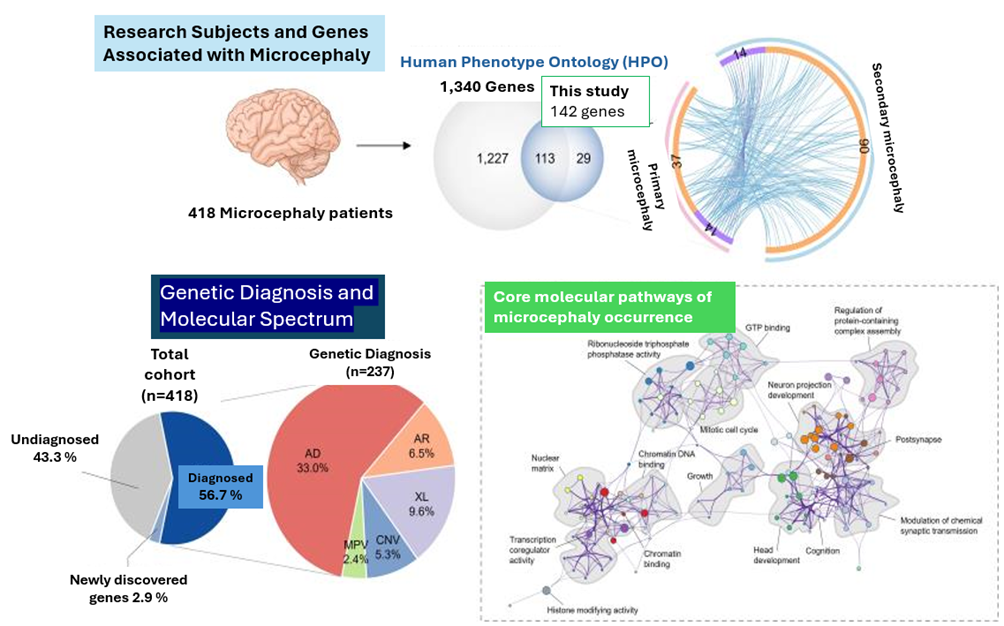Seoul National University Hospital and KAIST have identified the gene spectrum of microcephaly in Korea.
- Whole exome genome analysis was performed on about 1,000 patients and families with neurodevelopmental disorders accompanied by microcephaly.
- A total of 142 genes causing microcephaly were identified, and genetic causes were diagnosed in 57.6% of all patients.

Children with neurodevelopmental disorders often have microcephaly, characterized by a smaller head size than their peers, but the causes of its occurrence are unclear. Domestic researchers have identified the genetic spectrum associated with microcephaly and revealed the genetic causes in 56.7% of previously undiagnosed patients. This finding broadens our understanding of brain development pathways and provides a foundation for precise diagnosis in patients with neurodevelopmental disorders.
A joint research team comprising Professor Chae Jong-Hee from Seoul National University Hospital’s Department of Clinical Genomic Medicine, Professor Yoon Ki-Jun and researcher Jang Hyunsoo from KAIST’s Department of Biological Sciences, and Professor Yoon Jihoon from Gangnam Severance Hospital analyzed the whole exome genome data of 418 patients with neurodevelopmental disorders accompanied by microcephaly and their 632 family members.
Microcephaly is defined as a head circumference smaller than the average by more than two standard deviations for age and sex, which can lead to delayed brain growth and development. It is classified into primary microcephaly, where the head size is small from birth, and secondary microcephaly, where head growth stops after birth. Approximately 1,300 genes have been reported to be associated with the disorder.
However, the decisive genetic causes of microcephaly have not yet been clearly identified. To provide accurate diagnosis and treatment for patients with neurodevelopmental disorders and their families, and to assist in birth planning, it is important to identify the key genes involved in the occurrence of microcephaly.
The research team analyzed large-scale genomic data and identified 142 genes associated with the occurrence of microcephaly, clarifying the genetic cause in 56.7% (237 out of 418) of the patients. In particular, 29 genes were newly discovered, enhancing the genetic understanding of microcephaly. For example, one family that had experienced repeated miscarriages and developmental disabilities in children of unknown cause was able to find the exact genetic cause (a deletion in the SMPD4 gene) through this analysis, and they could proceed with family planning after receiving genetic counseling and preimplantation genetic diagnosis.
In addition, the research team confirmed that there are differences in the genetic mechanisms involved in primary and secondary microcephaly. Primary microcephaly is mainly influenced by early brain development pathways such as DNA damage response and cell division, whereas secondary microcephaly is associated with late-stage neural maturation pathways, including synapse formation and regulation, and the Wnt/β-catenin pathway.
Furthermore, analysis of undiagnosed patient groups led to the discovery of 12 additional candidate genes, among which the genes RTF1 and ASAP2 were found to play important roles in brain development. Experiments with brain organoids (artificial brain tissue) showed that the deficiency of these genes led to reduced proliferation of neural progenitor cells, which are at the stage before differentiation into neural cells.
This study provides the groundwork for accurate and timely genetic diagnosis of patients with neurodevelopmental disorders accompanied by microcephaly. The newly identified genes, in particular, offer diagnostic opportunities for patients and families who previously lacked answers, and may aid in reproductive planning for future generations.
The principal researcher, Professor Chae Jong-Hee (SNUH, Department of Clinical Genomic Medicine, Pediatric Cancer and Rare Disease Support Project, Rare Disease Division) said, "It is meaningful to have identified gene networks involved in brain size and brain function development through extensive genome analysis based on the actual head circumference data of children with neurodevelopmental disorders." He added, "As this genomic data accumulates, it will provide a starting point for the development of personalized therapies for children with neurodevelopmental disorders."
Professor Yoon Ki-Jun (Department of Biological Sciences, KAIST) said, “It is highly meaningful that through a brain organoid model derived from stem cells, we were able to confirm that the newly discovered candidate genes actually contribute to brain neurodevelopment.” He added, “This is a successful example of the convergence between clinical and basic medical research, demonstrating the potential for future brain organoid-based functional research and therapeutic technology development.”
This research was supported by the Lee Kun-Hee Pediatric Cancer and Rare Disease Overcoming Project, the National Research Foundation of Korea, and the Suh Kyung-Bae Research Foundation, and was recently published in the authoritative genomics journal Genome Medicine (Impact Factor: 11.2)

[From left in the photo] Professor Chae Jong-Hee (SNUH), Professor Yoon Ki-Jun and Researcher Jang Hyun-Soo (KAIST), and Professor Yoon Ji-Hoon (Gangnam Severance Hospital)